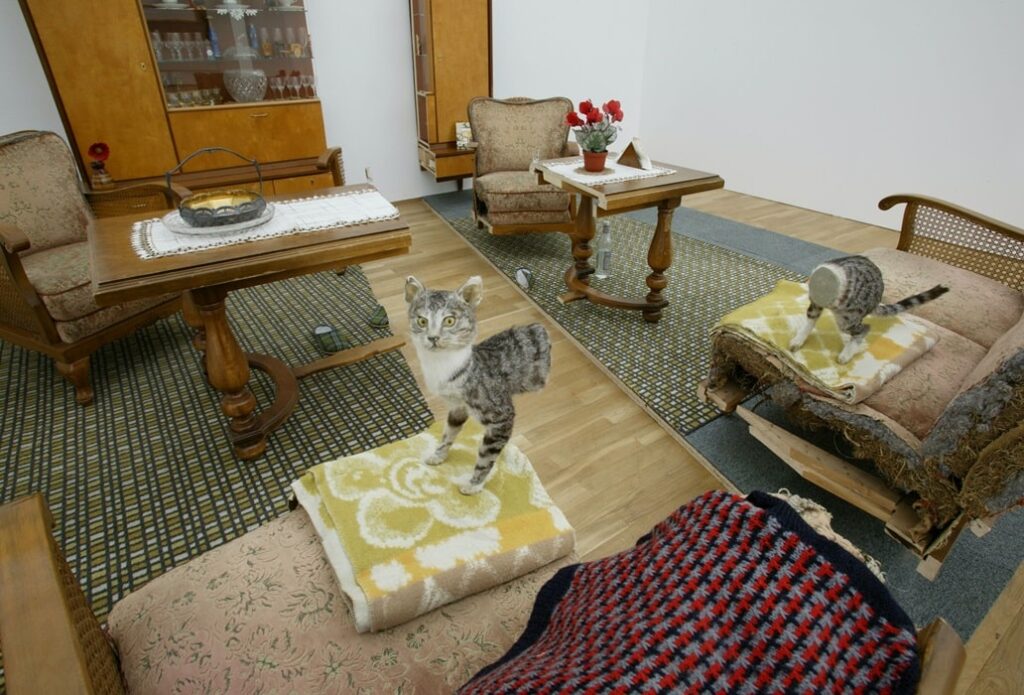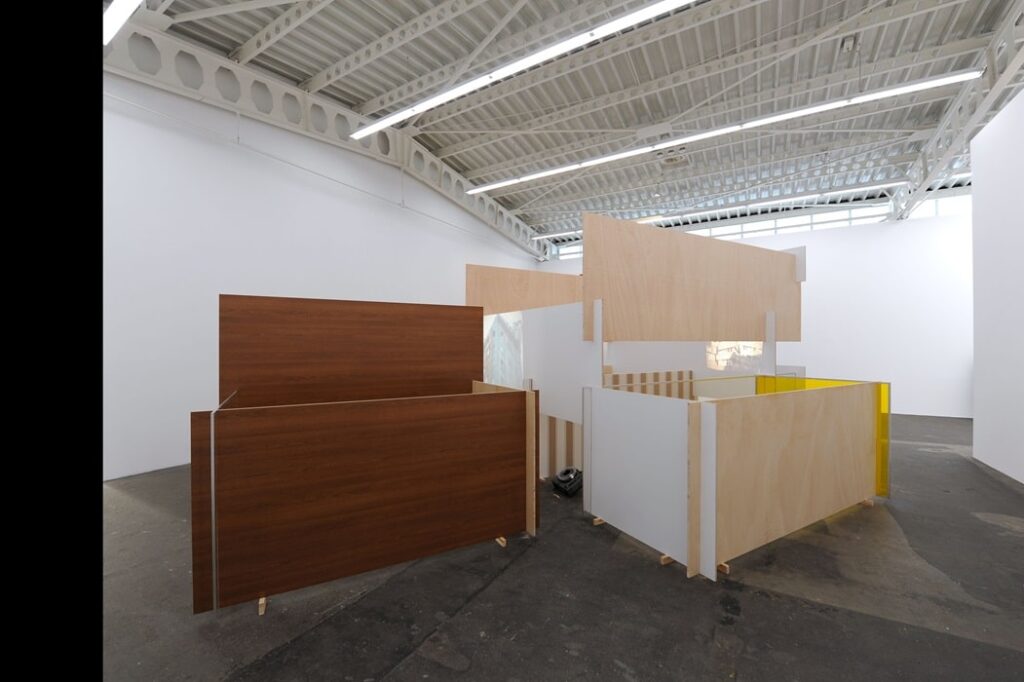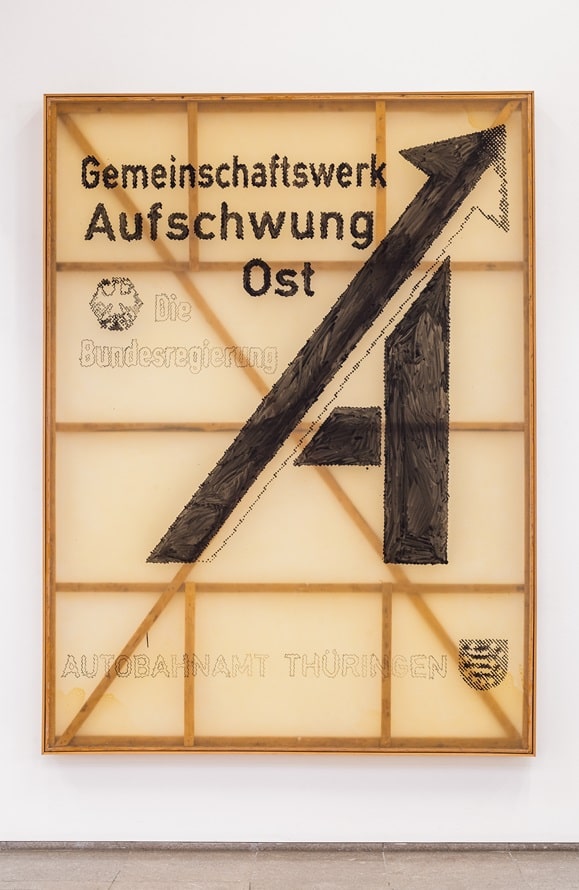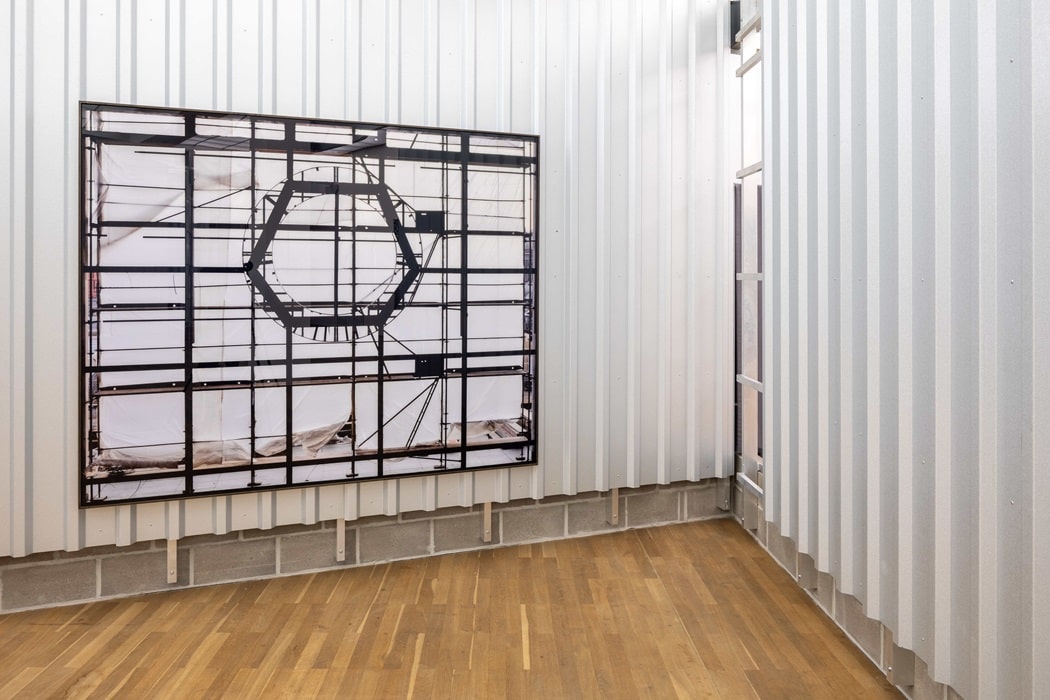A symposium at Hamburger Bahnhof – Nationalgalerie der Gegenwart on Friday, November 8 and Saturday, November 9, 2024 entitled “The West did not have to arrive in the East!” is dedicated to the consequences of 1989/1990 for art. Protagonists from various fields, art academies, the art market, funding structures, museums and artistic practice will present and discuss the consequences of the transformation after 1989/90 for the art world in front of a broad audience on the 35th anniversary of the opening of the Berlin Wall. Andrea Pichl’s solo exhibition “Value Economy”, which opens at Hamburger Bahnhof on Thursday, November 7, 2024, is dedicated to this topic from an artistic perspective.
Image above: Thomas Florschuetz, Ohne Titel / Untitled (Palast) 53, 2006, Farbfotografie, C-Print, Diasec®, 184 x 225 x 4 cm, Ausstellungsansicht „Nationalgalerie. Eine Sammlung für das 21. Jahrhundert“ © VG Bild-Kunst, Bonn 2024. Staatliche Museen zu Berlin, Nationalgalerie, 2008 erworben mit Unterstützung der Freunde der Nationalgalerie / Jacopo La Forgia
The opening of the Berlin Wall and the subsequent changes in 1989/1990 resulted in the transformation of all structures and areas of life in the former GDR: staff at art academies were mostly replaced by people from the ‘West’. Artists gained new freedoms, but at the same time were confronted with the fact that they no longer had any socio-economic security through the Association of Visual Artists. They had to find their way in the art market logic with galleries, fairs and competition from international players. There was no art market in the GDR that functioned in a market economy comparable to that of the FRG. Museums concentrated on closing gaps in modern and post-modern art. They put art created in the GDR into storage or equated the works and their producers with the system and its regime. Only a few contemporary artists from the territory of the former GDR received institutional recognition through individual presentations and prizes or participation in biennials and other internationally oriented exhibitions.
During the two-day symposium, contemporary witnesses of the 1990s and younger actors will come together to share their experiences and engage in a productive exchange about continuities and changes. The central questions will be: How did the actors individually experience the transformation after 1989? What was lost? Where was growing together made productive? How do artists relate to the history of the GDR and the period of transformation? What influence do economic structures have? Is there an Eastern art scene today? And if so, what characterizes it? How is the institutional art scene in the East organized? And how visible are curators and artists with an Eastern biography in institutions? Building on these questions, the symposium at the Hamburger Bahnhof, which was located directly on the Berlin Wall during the division of Germany, aims to create networks and formulate concrete wishes and ideas for the future.

Till Fellrath, Co-Director Hamburger Bahnhof – Nationalgalerie der Gegenwart: “With this symposium and Andrea Pichl’s exhibition, Hamburger Bahnhof would like to invite visitors to reflect on the after-effects of the division of Germany in today’s art scene. With its special location on the former Berlin Wall, Hamburger Bahnhof would like to set an example for dialog and exchange and continue to open itself up to a broad public.”
Gitte Zschoch, Secretary General of the ifa – Institute for Foreign Cultural Relations: “The tasks of the Centre for Art Exhibitions of the GDR (ZfK) were similar to those of the ifa – both institutions organized cultural exchange through exhibitions abroad and invited international artists. With reunification, not only the graphic collection with around 10,000 works by 630 artists was transferred to the ifa, but also the responsibility to commemorate the ZfK. Making this important and ambivalent testimony to GDR art visible and critically examining the ifa’s role in this context are particularly important to me. I am delighted that the symposium is focusing on East German art and its history.”

Carsten Schneider, Minister of State to the Federal Chancellor and Federal Government Commissioner for East Germany: “Almost 35 years after reunification, I am observing a rapprochement between East and West in the field of art. This was not always the case and East German art had to fight for a long time to be recognized as all-German art. The fact that this path is now being examined more closely in a symposium is important and consistent. This is the only way to take a comprehensive look at the diverse experiences of transformation and rapprochement. I am looking forward to the discussions during the symposium and have gladly taken on the patronage for it.”
Among the panelists are: Thomas Bauer-Friedrich, Director of the Moritzburg Art Museum in Halle (Saale); Prof. Dr. Dieter Daniels, Professor of Art History and Media Theory at the Academy of Visual Arts Leipzig; Dr. Hildtrud Ebert, art historian, Berlin; Elke Hannemann, Senior Director (Leipzig), Galerie EIGEN+ART, Berlin/Leipzig; Dr. Gabriele Knapstein, Deputy Director and Head of Collection, Hamburger Bahnhof – Nationalgalerie der Gegenwart, Berlin; Via Lewandowsky, visual artist, Berlin; Arne Linde, gallery owner and founder of Galerie ASPN, Leipzig; Friedrich Loock, LOOCK Gallery (1988-2008 Galerie Wohnmaschine), Berlin; Pham, Minh Duc, visual artist and performer, Berlin; Andrea Pichl, visual artist, Berlin; Dr. Angelika Richter, Rector weißensee academy of art berlin; Prof. Ricarda Roggan, Professor of Photography at the ABK Stuttgart; Hilke Wagner, Director of the Albertinum, Staatliche Kunstsammlungen Dresden; Gitte Zschoch, Secretary General of the ifa (Institute for Foreign Cultural Relations); Franciska Zólyom, Director of the Gallery of Contemporary Art Leipzig.
The symposium is conceived by Till Fellrath, Co-Director Hamburger Bahnhof, Gabriele Knapstein, Deputy Director and Head of Collection at Hamburger Bahnhof and Sven Beckstette, Research Associate Hamburger Bahnhof with the freelance art historian and journalist Sarah Alberti.
The symposium is under the patronage of Carsten Schneider, Minister of State to the Federal Chancellor and Federal Government Commissioner for Eastern Germany.

PROGRAM
The symposium is open to the public and can be attended free of charge without registration. The event will be held in German; simultaneous translation into English will be provided on site.
Friday, November 8, 2024
2 p.m. Welcome
Till Fellrath, Co-Director of the Hamburger Bahnhof – Nationalgalerie der Gegenwart
2:10 p.m. Greeting by patron Carsten Schneider, Minister of State to the Federal Chancellor and Federal Government Commissioner for Eastern Germany
Moderation: Tanja Samrotzki
2:30 p.m. to 4 p.m.
Museums & Collections
Impulse: The Dresden Picture Controversy and the Consequences for the Albertinum
Hilke Wagner, Director of the Albertinum, Staatliche Kunstsammlungen Dresden
Panel:
Thomas Bauer-Friedrich, Director of the Moritzburg Art Museum Halle (Saale)
Hilke Wagner, Director of the Albertinum, Dresden State Art Collections
Dr. Gabriele Knapstein, Deputy Director and Head of Collection Hamburger Bahnhof – Nationalgalerie der Gegenwart, Berlin
BREAK
4:30 p.m. to 6 p.m.
Art market
Impulse: “Outsiders – Frontrunners” On the founding and development of Galerie ASPN in Leipzig since 2005
Arne Linde, gallery owner and founder of Galerie ASPN, Leipzig
Panel:
Elke Hannemann, Senior Director (Leipzig), Galerie EIGEN+ART, Berlin/Leipzig
Arne Linde, gallery owner and founder of the gallery ASPN, Leipzig
Friedrich Loock, LOOCK Gallery (1988-2008 Galerie Wohnmaschine), Berlin
Saturday, November 9, 2024
11:30 a.m. to 1 p.m.
Panel art academies
Impulse: “Becoming annoying competition?” The situation of art academies in the eastern part of Berlin after 1989
Dr. Angelika Richter, Rector weißensee academy of art berlin
Panel:
Prof. Dr. Dieter Daniels, Professor of Art History and Media Theory at the Academy of Visual Arts Leipzig
Dr. Angelika Richter, Rector weißensee academy of art berlin
Prof. Ricarda Roggan, Professor of Photography at the ABK Stuttgart
1 p.m. to 2 p.m BREAK
2 p.m. to 3:30 p.m. Artistic positions
Impulse: On the artistic practice of Andrea Pichl, Via Lewandowsky and Pham, Minh Duc
Dr. Sven Beckstette, research associate at Hamburger Bahnhof – Nationalgalerie der Gegenwart, Berlin
Panel:
Andrea Pichl, visual artist, Berlin
Via Lewandowsky, visual artist, Berlin
Pham, Minh Duc, visual artist and performer, Berlin
BREAK
4 p.m. to 5:30 p.m.
Panel Structures
Impulse: On the foundation of the Gallery of Contemporary Art Leipzig
Franciska Zólyom, Director of the Gallery for Contemporary Art Leipzig
Panel:
Dr. Hildtrud Ebert, art historian, Berlin
Franciska Zólyom, Director of the Gallery of Contemporary Art Leipzig
Gitte Zschoch, Secretary General of the ifa (Institute for Foreign Cultural Relations)
WHEN?
Symposium dates: Friday, November 8 – Saturday, November 9, 2024
Opening hours: Tuesday – Wednesday, Friday, 10 a.m. – 6 p.m., Thursday, 10 a.m. – 8 p.m., Saturday – Sunday, 11 a.m. – 6 p.m.
WHERE?
Hamburger Bahnhof – Nationalgalerie der Gegenwart
Invalidenstraße 50/51
10557 Berlin-Mitte
COST?
Free admission






